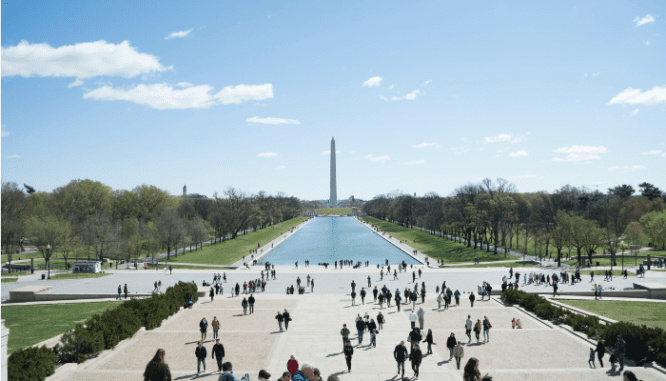Going Down in History: How to Buy House in Washington DC
- Published on
- 5 min read
-
 Elyse O'Dwyer Contributing AuthorClose
Elyse O'Dwyer Contributing AuthorClose Elyse O'Dwyer Contributing Author
Elyse O'Dwyer Contributing AuthorElyse O'Dwyer is a real estate and lifestyle freelance writer featured in McSweeney's, Insider, and SheKnows. In addition to three years of experience creating real estate and interior design content, she worked in legal real estate for over ten years.
Washington D.C.: the cherry blossoms, the landmarks, over 70 museums, culture and diversity, hundreds of years of history and history in the making. There are many draws as Washington D.C. has long been a destination city for tourists, but if you’re thinking about a permanent move there, you’re in more than good company. It’s become a popular city for the culture and nightlife, but also for the many parks, nature, and outdoor activities, not to mention the diversity and career opportunities. A variety of neighborhoods appeal to any type of buyer, and a range of options from small studio apartments to large single-family homes are available (if you know where to look).
In 1790 when Maryland and Virginia agreed to cede some land to become the nation’s capital, the city’s designer Pierre Charles L’Enfant envisioned a bold and modern city. And while Washington D.C.’s streets are filled with history, museums and landmarks, L’Enfant’s original vision endures as Washington D.C. was recently ranked as the third-best city for millennials.
That said, if you want to buy a house here, you’ll be facing stiff competition and questions that you might not have in other cities. How old is the air conditioning system? What do you need to know about how the humidity could affect your house? And what makes a strong offer in the D.C. area?
We’ve talked to experts who deal with home sales every day in the nation’s capital and collected the advice they shared for buyers. Read on to learn how to find your D.C. dream home! To help us navigate the contrasting neighborhoods, competitive market, and the appeal of this world-class city, we spoke with real estate agent David Bediz, who sells home 61% faster than the average Washington, D.C. agent — and who says that although the city ranks as the fourth-most-expensive city in the country, the culture, art, and restaurant scenes make it worth the cost of living.

Why choose D.C.?
Bediz notes that locals probably only visit tourist attractions like the National Mall when they have family in town visiting. Instead, he says, many young people fill their weeknights with the social sports scene, as there are tons of intramural team sports to join, from softball to bocce ball to kickball.
At one point, Bediz says he was a member of four different leagues. It’s a huge part of the culture.
D.C. boasts the best of all worlds — a bustling city and easy access to outdoor recreation. Lovers of a dynamic lifestyle will appreciate the access to the many parks D.C .has to offer, in particular the expansive Rock Creek Park. With 1,754 acres, it trumps Manhattan’s Central Park in size, and it’s full of fun activities.
Outdoors, you can horseback ride, go on a hike, play golf, and even boat on the Potomac. Indoors, there’s a planetarium and a nature center to enjoy with your family.
Budgeting for a (white?) house in Washington D.C.
Don’t get sticker shock if you’re ready to make the move; as of September 2021, according to The District of Columbia Association of Realtors, the average cost of a home in the area is $652,000, which is about double the national average of $324,900. That said, you do get a break on taxes, as D.C. residents pay some of the lowest property taxes in the country at $0.85 per $100 in assessed value.
While you may save on taxes, you’ll also want to budget for a potential HOA, as they are common in the area.

Which D.C. neighborhood is right for you?
Selecting a neighborhood is key in your search.
“One of D.C.’s trademarks is, it’s very diverse,” Bediz says. ‘It can look different and feel different from one block to the next; it’s very diverse racially, socially and economically.” He says that simply driving around is a great way to get a feel for your preferred locations.
If you’re in government, you’ll likely want to live in Capitol Hill, but there are other great neighborhoods nearby, like Trinidad and Hill East. Bediz goes on to list Dupont Circle, Woodley Park, and Logan Circle as good options if you want to take the Metro.
Capitol Hill
This is a great place to live if you work in government; you’ll have access to the government buildings and live among many historic landmarks. But there’s also nightlife and many restaurants to choose from here. In this area, you’ll have your pick of 20th Century Row Houses.
Dupont Circle
It’s an area filled with boutique shops and art galleries, for those who appreciate the finer things in life. There’s even a popular farmer’s market on Sundays for a community feel. You can find a lot of Victorian homes in this area.
Woodley Park
Home to the Smithsonian Zoo, Woodley Park is a great destination for animal and outdoor lovers with its close proximity to Rock Creek Park. And it’s an easy ride to work on the Metro.
Logan Circle
You’ll have more than one go-to bar to choose from in this hip neighborhood with lots of trendy shops and restaurants. You’ll find plenty of turn-of-the-century townhouses surrounding their circular park.
Adams Morgan
A stylish entry in the D.C. neighborhood scene, there is an abundance of vintage and trendy clothing shops in addition to the active nightlife. The old and new trend continues in housing, home to both row style and contemporary houses.
Bediz notes that there are many excellent public, private, and charter schools in the city. He explains that when it comes to school districts, you should do your homework.
One of his clients is an administrator in the public school system who urges people to visit the neighborhoods they’re interested in and meet some of the teachers and principals at the schools so they can get firsthand information, rather than relying solely on rating websites.
D.C. Architectural Style
If you want your home to reflect the city’s history, there are many classic home styles to choose among, like Craftsmans and Colonials, but if you’re more new-school, you’ll find many contemporary homes in your search as well.
Classic home styles vary from neighborhood to neighborhood. If you ask locals in the know, you may want to consider living in the quintessential D.C. home: The Wardman Style. Named for real estate developer Harry Wardman, beyond developing many homes in the area himself, his influence is indelible.
Bediz explains, “There are probably 100,000 houses that were built in this style in D.C. They’re mostly row houses with front porches, dormer windows up top that are flattened out a little like Frank Lloyd Wright style. They have an Arts and Crafts feel, but they’re all brick, and the layout is almost exactly the same.”
He says while structurally they’re generally similar to one another, there are a lot of opportunities to make changes and updates to your own taste. “It feels comfortable and familiar, but it’s like a blank canvas — you can do what you want.”
One downside to the ultimate in D.C. craftsmanship? They generally were only built with one full bathroom upstairs, which may be enough for the minimalists out there, but if you’re not living alone, you may require a second space so there’s not a daily battle for first shower dibs. Bediz says that many homes do feature an added second bathroom in the basement, so there’s always the option to explore the costs of adding a bathroom to your home in the future.
If you’re ready to buy your own Wardman, you’ll be facing stiff competition. The area is desirable and generally always enjoys a strong seller’s market. Bediz spoke about a house sold in late 2021 that had over 100 offers, in which the winning offer literally wrote in an infinity symbol. He says buyers will have to have the patience to get into the home they want.
“For buyers, you can’t run the show, it’s just not possible — you have to follow their lead, and you don’t get to call the shots.” Offers with few or no contingencies could win favor with the seller.
Many of the buildings you’ll see in Washington D.C. are divided into two units conveniently for rental space, which is a great option if you’re looking for additional income. Bediz says that many people living there rent out their basements to help pay their mortgage.
Choosing to open your home to vacationers or renters is a personal decision, but it can make a huge impact on your monthly budget; if you live in an area with a lot of tourism traffic, it can be something to consider. In a city with a high cost of living, this is an option that can help you live more affordably and make your investment work for you.
If you do plan to rent out a portion of your home, you’ll need a Certificate of Occupancy for the property, which you can verify at the DCRA Property Information Verification System, plus an inspection to confirm your property is habitable and up to code.

Protect your D.C. purchase with a home inspection
The extreme climate means there are some major problems to protect yourself against as a homebuyer. We spoke with local home inspector Khaled Alkurd of NextDay Inspect, who told us that while they’re not the most common, the most detrimental concerns are roof or attic issues that are not discovered prior to purchase.
These are items that will be very costly to fix and require a detailed and knowledgeable inspector to ensure you don’t take a huge financial hit on your new home. Common prevalent local concerns include wood-destroying organisms (think termites) and the cancer-causing element radon.
The mercilessly humid summers mean you’ll want to budget for tuning and maintenance of the AC system, which typically costs “Five to ten percent max of the replacement cost, so it’s a good allocation of resources.” Maintenance is key, as the total replacement of an A/C system can run on average from $5,000 to $10,000, so you’re looking at between $250 and $1,000 to prevent a bigger problem.
Beyond that, Alkurd says to extend that maintenance work to your dryer unit, which will also require cleaning; your gutters; and trimming tree limbs hanging over your roof. He advises that keeping your foundation intact is key and recommends using plastic extensions to divert rainwater away from your foundation.
A red flag Alkurd says to be mindful of? A negative grade around the foundation could cause you costly problems in the future. He says you want to avoid sloping toward the house. “All it takes is one pocket in the wrong direction will result in water pooling and eventual foundation problems.”
Tricks to conceal problems tend to be aesthetic and generally can’t disguise major issues, such as a rug covering a mark on the floor or a photo over a hole in the wall; these won’t grow into larger problems. But there may be evidence of issues from the past if you’re paying attention. “If we see a lot of prior work done at different instances in time, it means that the prior owner tried to address concerns and we don’t know how effective that was.”
Ultimately, Alkurd urges buyers to attend their inspections and ask questions and take notes as they go along.
How to win your dream D.C. house
Buying in a competitive city will always be a challenge, but working with a knowledgeable agent can help you avoid missing out on a deal or leaving money on the table.
If you connect with a top buyer’s agent, even in a competitive market like Washington, D.C., you can find the perfect home. The best agents in D.C. can save their clients up to 85% on their home purchase (yes, you read that right) — that’ll cover a lot of annual museum memberships for your family!
Header Image Source: (Mark Tegethoff / Unsplash)
